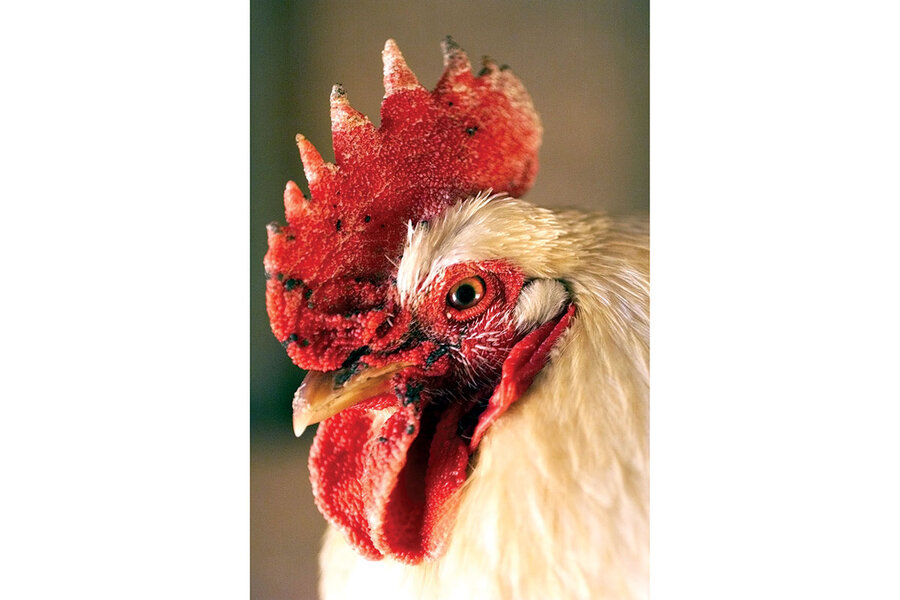Our animal problem comes home to roost
Loading...
My girls, who are 6 and 8, have an animal problem. I can blame only myself, since my poor husband wants nothing to do with muddy dogs, shedding cats, and messy chickens. He believes joy is found in peaceful cleanliness. He likes order. Creatures who regularly do what is asked of them.
My girls and I like fur and snuggles. Creatures who display goofy gratitude for their suppers. Animals who cannot speak but who talk nonetheless.
And oh, how they are talking.
Our predicament began in the fall, when I decided we needed more chickens. The local wildlife had taken enough of our small flock that I was worried about the birds staying warm in the New England winter. Besides, four eggs a day are better than two. More animals are better than fewer – or so I thought.
I found a woman who was looking to get rid of her 10-week-old chicks. She and her family were moving, she explained, and the birds had to go. So my daughters and I drove to her house, cooed at the peeping balls of soft, buff-tan feathers, and brought four home.
The woman said she was pretty sure they were all female. Although, she added, “it’s hard to tell when they’re young.”
We fed those pullets – chicken teenagers – all winter. We mourned when a hawk got one, and then another. We built better chicken defenses. My daughters tried out names – Sparkle, Fluffy, Cutie-Pie – but none really stuck, mostly because we couldn’t tell them apart. Or maybe we knew, somewhere deep down, that something was amiss.
When spring arrived in its muddy, gray-lit New England way, we let the chickens out of their coop to range freely again, eager for them to start laying. Our new rooster, a lovely black and white breed called a “cuckoo maran” whom we acquired to care for our growing flock, seemed to do his job well. He watched the sky for predators, stretched out his glorious tail feathers, and called the hens over to morsels he found in the wet earth.
I can’t wait to get eggs, I gushed to my girls. They responded by drawing pictures of hens with hearts and rainbows.
Then one young hen crowed.
That’s a rooster, my husband said.
No way, I replied.
It crowed again. I got on Google.
Hens can crow, I informed him triumphantly. (The internet never lies.) It’s rare, I explained, but it happens.
Sure, he said.
I kept watch over the flock. I started noticing how the two young birds began to face off. They’d shuffle sideways, scratching the ground with their talons, then fly at each other full-force.
The young chicken crowed again. The big rooster crowed. And finally, a few days later, the second youngster added his cock-a-doodle-doo.
You have three roosters, my husband said, walking through the door after work one day, going, no doubt, to the happy place in his mind where his wife has not acquired loud and useless poultry lawn ornaments.
I went outside again, and the two old hens seemed to stop their pecking for a moment to stare at me reproachfully. One of the young chickens tried to shuffle up to them in a clumsy version of courting. The old hen pecked him on the head.
Told you, my husband said.
The mornings have gotten loud. I have locked the two cockerels out of the coop at night to protect the hens from unwanted advances. At 5 a.m. a chorus of roosters greets me as I let the dogs out.
Morning, I say back.
Chicken people tell me this situation is untenable. Three roosters and two hens is a blood bath, one said. Friends have offered to “soup pot” them for me. But my girls have started a Save-the-Roosters campaign. They have produced more drawings with hearts. They sing a “chickens are pets” song that they made up. They want me to build a “bachelor coop” near the neighboring cornfields. (My mother suggests adding a pingpong table and an old leather chair.)
This is your fault, my husband says.
So I am stuck. I don’t know what to do about the roosters, or the kids. Their animal problem has come home to roost.
But then the other day, somewhere amid the chaos and the crowing and the chicken antics on my front porch, I found myself laughing. Mother Nature has a glorious sense of humor. Once again, I realized, she has brought me messy joy that I would have never designed myself.
I saw an advertisement for spring chicks that afternoon.
Girls, I whispered to my daughters, do you think we should get the roos their own flocks?








